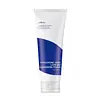What's inside
What's inside
 Key Ingredients
Key Ingredients

 Benefits
Benefits

 Concerns
Concerns

 Ingredients Side-by-side
Ingredients Side-by-side

Water
Skin ConditioningGlycerin
HumectantMyristic Acid
CleansingStearic Acid
CleansingPEG-32
HumectantPotassium Hydroxide
BufferingPalmitic Acid
EmollientLauric Acid
CleansingLauryl Glucoside
CleansingPropanediol
SolventGlyceryl Stearate
EmollientPEG-100 Stearate
Parfum
MaskingPolyquaternium-7
1,2-Hexanediol
Skin ConditioningDisodium EDTA
Sodium Benzoate
MaskingEthylhexylglycerin
Skin ConditioningCamellia Sinensis Leaf Water
MaskingCamellia Sinensis Leaf Extract
AntimicrobialButylene Glycol
HumectantLactic Acid
BufferingAlcohol
AntimicrobialCamellia Sinensis Root Extract
PerfumingPhenoxyethanol
PreservativeWater, Glycerin, Myristic Acid, Stearic Acid, PEG-32, Potassium Hydroxide, Palmitic Acid, Lauric Acid, Lauryl Glucoside, Propanediol, Glyceryl Stearate, PEG-100 Stearate, Parfum, Polyquaternium-7, 1,2-Hexanediol, Disodium EDTA, Sodium Benzoate, Ethylhexylglycerin, Camellia Sinensis Leaf Water, Camellia Sinensis Leaf Extract, Butylene Glycol, Lactic Acid, Alcohol, Camellia Sinensis Root Extract, Phenoxyethanol
Water
Skin ConditioningSodium Cocoyl Isethionate
CleansingGlycerin
HumectantSodium Methyl Cocoyl Taurate
CleansingGlycol Distearate
EmollientPotassium Cocoate
EmulsifyingPotassium Cocoyl Glycinate
Caprylyl/Capryl Glucoside
CleansingSodium Hyaluronate
HumectantHydrolyzed Hyaluronic Acid
HumectantHydroxypropyltrimonium Hyaluronate
Sodium Hyaluronate Crosspolymer
HumectantHyaluronic Acid
HumectantSodium Acetylated Hyaluronate
HumectantHydrolyzed Sodium Hyaluronate
Skin ConditioningPotassium Hyaluronate
Skin ConditioningButylene Glycol
HumectantEclipta Prostrata Leaf Extract
Skin ConditioningLaminaria Japonica Extract
Skin ProtectingAmaranthus Caudatus Seed Extract
Skin ConditioningCentella Asiatica Extract
CleansingFicus Carica Fruit Extract
HumectantUlmus Davidiana Root Extract
Skin Conditioning1,2-Hexanediol
Skin ConditioningGlycine
BufferingSerine
MaskingGlutamic Acid
HumectantAspartic Acid
MaskingLeucine
Skin ConditioningAlanine
MaskingArginine
MaskingLysine
Skin ConditioningIsoleucine
Skin ConditioningPhenylalanine
MaskingProline
Skin ConditioningThreonine
Tyrosine
MaskingValine
MaskingHistidine
HumectantCysteine
AntioxidantMethionine
Skin ConditioningDipotassium Glycyrrhizate
HumectantBeta-Glucan
Skin ConditioningPanthenol
Skin ConditioningCeramide NP
Skin ConditioningHydrogenated Lecithin
EmulsifyingFructooligosaccharides
HumectantAllantoin
Skin ConditioningOryza Sativa Bran Extract
Skin ConditioningPentylene Glycol
Skin ConditioningSodium Chloride
MaskingHydroxyacetophenone
AntioxidantCitric Acid
BufferingDisodium EDTA
Polyquaternium-39
Decylene Glycol
Skin ConditioningEthylhexylglycerin
Skin ConditioningWater, Sodium Cocoyl Isethionate, Glycerin, Sodium Methyl Cocoyl Taurate, Glycol Distearate, Potassium Cocoate, Potassium Cocoyl Glycinate, Caprylyl/Capryl Glucoside, Sodium Hyaluronate, Hydrolyzed Hyaluronic Acid, Hydroxypropyltrimonium Hyaluronate, Sodium Hyaluronate Crosspolymer, Hyaluronic Acid, Sodium Acetylated Hyaluronate, Hydrolyzed Sodium Hyaluronate, Potassium Hyaluronate, Butylene Glycol, Eclipta Prostrata Leaf Extract, Laminaria Japonica Extract, Amaranthus Caudatus Seed Extract, Centella Asiatica Extract, Ficus Carica Fruit Extract, Ulmus Davidiana Root Extract, 1,2-Hexanediol, Glycine, Serine, Glutamic Acid, Aspartic Acid, Leucine, Alanine, Arginine, Lysine, Isoleucine, Phenylalanine, Proline, Threonine, Tyrosine, Valine, Histidine, Cysteine, Methionine, Dipotassium Glycyrrhizate, Beta-Glucan, Panthenol, Ceramide NP, Hydrogenated Lecithin, Fructooligosaccharides, Allantoin, Oryza Sativa Bran Extract, Pentylene Glycol, Sodium Chloride, Hydroxyacetophenone, Citric Acid, Disodium EDTA, Polyquaternium-39, Decylene Glycol, Ethylhexylglycerin
 Reviews
Reviews

Ingredients Explained
These ingredients are found in both products.
Ingredients higher up in an ingredient list are typically present in a larger amount.
1,2-Hexanediol is a synthetic liquid and another multi-functional powerhouse.
It is a:
- Humectant, drawing moisture into the skin
- Emollient, helping to soften skin
- Solvent, dispersing and stabilizing formulas
- Preservative booster, enhancing the antimicrobial activity of other preservatives
Butylene Glycol (or BG) is used within cosmetic products for a few different reasons:
Overall, Butylene Glycol is a safe and well-rounded ingredient that works well with other ingredients.
Though this ingredient works well with most skin types, some people with sensitive skin may experience a reaction such as allergic rashes, closed comedones, or itchiness.
Learn more about Butylene GlycolDisodium EDTA plays a role in making products more stable by aiding other preservatives.
It is a chelating agent, meaning it neutralizes metal ions that may be found in a product.
Disodium EDTA is a salt of edetic acid and is found to be safe in cosmetic ingredients.
Learn more about Disodium EDTAEthylhexylglycerin (we can't pronounce this either) is commonly used as a preservative and skin softener. It is derived from glyceryl.
You might see Ethylhexylglycerin often paired with other preservatives such as phenoxyethanol. Ethylhexylglycerin has been found to increase the effectiveness of these other preservatives.
Glycerin is already naturally found in your skin. It helps moisturize and protect your skin.
A study from 2016 found glycerin to be more effective as a humectant than AHAs and hyaluronic acid.
As a humectant, it helps the skin stay hydrated by pulling moisture to your skin. The low molecular weight of glycerin allows it to pull moisture into the deeper layers of your skin.
Hydrated skin improves your skin barrier; Your skin barrier helps protect against irritants and bacteria.
Glycerin has also been found to have antimicrobial and antiviral properties. Due to these properties, glycerin is often used in wound and burn treatments.
In cosmetics, glycerin is usually derived from plants such as soybean or palm. However, it can also be sourced from animals, such as tallow or animal fat.
This ingredient is organic, colorless, odorless, and non-toxic.
Glycerin is the name for this ingredient in American English. British English uses Glycerol/Glycerine.
Learn more about GlycerinWater. It's the most common cosmetic ingredient of all. You'll usually see it at the top of ingredient lists, meaning that it makes up the largest part of the product.
So why is it so popular? Water most often acts as a solvent - this means that it helps dissolve other ingredients into the formulation.
You'll also recognize water as that liquid we all need to stay alive. If you see this, drink a glass of water. Stay hydrated!
Learn more about Water